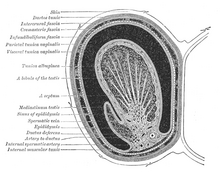This is an old revision of this page, as edited by Diberri (talk | contribs) at 18:20, 14 April 2004 ({{msg:reproductive_system}}). The present address (URL) is a permanent link to this revision, which may differ significantly from the current revision.
Revision as of 18:20, 14 April 2004 by Diberri (talk | contribs) ({{msg:reproductive_system}})(diff) ← Previous revision | Latest revision (diff) | Newer revision → (diff)

The testicles, known medically as testes (singular testis), are the male generative glands in animals. Male mammals have two testicles, contained within a pouch termed the scrotum.
Like the ovaries (to which they are homologous), testicles are components of both the reproductive system (being gonads - see sex organs) and the endocrine system (being endocrine glands). The respective functions of the testicles are:
- producing sperm (spermatozoa)
- producing male sex hormones, mainly testosterone
Both functions of the testicle, sperm-forming and endocrine, are under control of gonadotropic hormones produced by the anterior pituitary:
- lutenizing hormone (LH) and
- follicle-stimulating hormone (FSH).
Under a tough fibrous shell, the tunica albuginea, the testis contains very fine coiled tubes called the seminiferous tubules. The tubes are lined with a layer of cells that, from puberty into old-age, produce sperm cells. The seminiferous tubules lead to the epididymis, where newly created sperm cells mature, and then into vas deferens (also called the ductus deferens) which opens into the urethra. Upon any sufficient sexual arousal, the sperm cells move through the ejaculatory duct and into the prostatic urethra, where the prostate, through muscular contractions, ejaculates the sperm, mixed with other fluids, out through the penis. (The genital anatomy described here, along with the neuroanatomy and hormonal systems that enable it to perform ejaculation, have as primary evolutionary functions the impregnation of a fertile female of the same species (or a sufficiently close one), via sexual intercourse with her.)
Between the seminiferous tubules are special cells called interstitial cells (Leydig cells) where testosterone and other androgens are formed.
The testicles are well-known to be very sensitive to impact and injury. This has been a rich source of humor for jokes and comedic routines. Slang terms for testicles, like "balls" or the Spanish "cojones" are often used in everyday speech to denote courage or audacity, as in "He has balls to do that."
The most important diseases of testicles are:
- inflammation of the testicles, called orchitis
- testicular cancer and other neoplasms
- accumulation of clear fluid around a testicle, called hydrocele testis
- inflammation of the epididymis, called epididymitis
- spermatic cord torsion also called testicular torsion
- varicocele
The removal of one or both testicles is termed
- orchidectomy, in medicine (where orchiectomy and orchectomy are equivalent synonyms), and
- castration in general use, especially when done for the benefit of others than the subject.
At least for humans, testicular prostheses are available to mimic the appearance and feel of one or both testicles, when absent as from injury or medical treatment.
See also:
- cryptorchismus
- infertility
- orchidometer
- sterilization (vasectomy)
| Female reproductive system | |||||||||||||||||||||||||||||||
|---|---|---|---|---|---|---|---|---|---|---|---|---|---|---|---|---|---|---|---|---|---|---|---|---|---|---|---|---|---|---|---|
| Internal |
| ||||||||||||||||||||||||||||||
| External |
| ||||||||||||||||||||||||||||||
| Blood supply | |||||||||||||||||||||||||||||||
| Other | |||||||||||||||||||||||||||||||